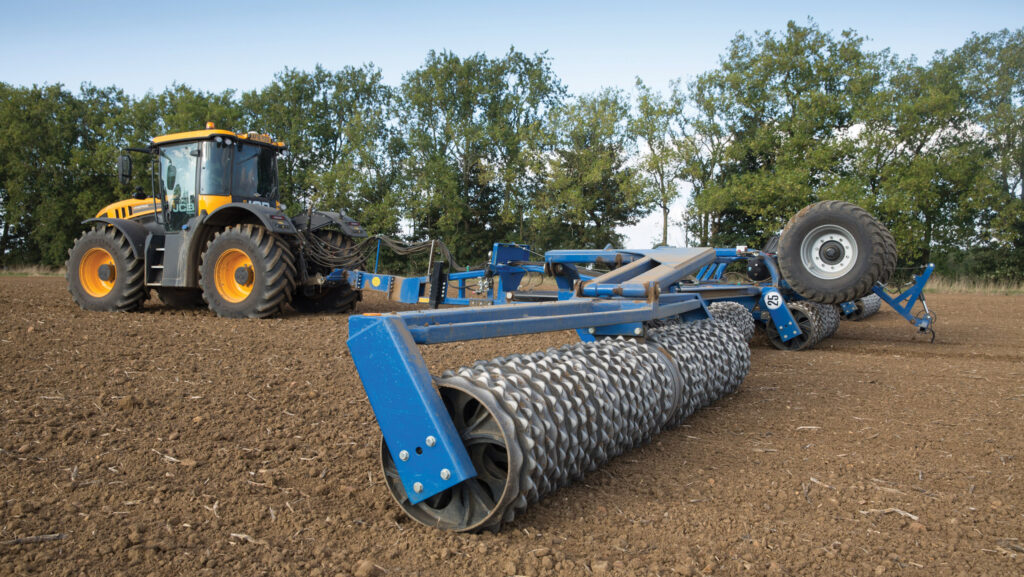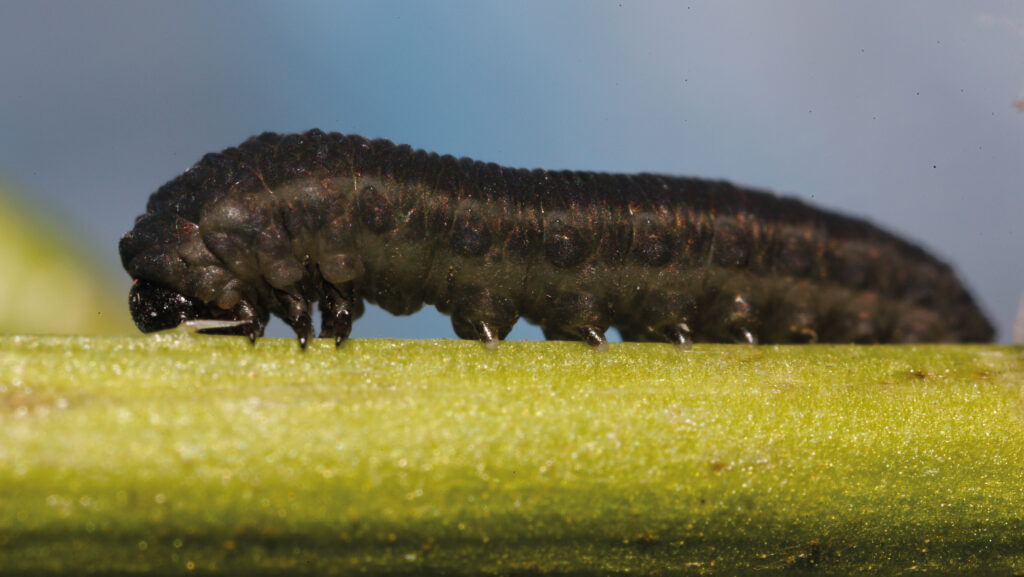Crop Watch: Pre-em strategies in wheat, turnip sawfly in OSR
 © Tim Scrivener
© Tim Scrivener This week, our agronomists consider pre-emergence herbicide programmes in winter wheat and the rising prest threat.
Turnip sawfly larvae is affecting some oilseed rape crops in the East and with blackgrass slow to flush, there is debate on farm whether to drill.
See also: Wilts OSR grower reveals lessons from sheep grazing trials
North
Mary Munro, Munro Agricultural Consultancy (E Lothian)
The East of Scotland is still basking in the afterglow of harvest 2025 – early, dry, and producing record yields for many growers.
It meant for once we experienced the sort of autumn that is probably common in East Anglia.
Those growers who like a green cover got their cover crops sown in August or early September and enough rain fell to get them going.
Oilseed rape, similarly, was sown in good time into seed-beds that were perhaps a tad dry for residual herbicides, but definitely too dry for slugs.
The dry sunny weather was ideal for cabbage stem flea beetle and some crops took a bit of a hit, but most are up and away.
OSR crops are now at four to six leaves or more, with herbicides on, and the winter barley volunteers are beginning to show the effects of graminicides now.
The early sown wheats are at two to three leaves and clean.
My growers tend to prefer early post-emergence applications of herbicide and these are going on now – a generous rate of generic Liberator (diflufenican + flufenacet) plus Tower/Tribal (chlorotoluron + diflufenican + pendimethalin) to try and get on top of groundsel and give a broad spectrum of control.
These farms do not have blackgrass, but the bromes are never far away and need to be kept under control.
Where the grassweeds are more of an issue I tend to avoid the generics, and may go with Luximo (cinmethylin) in the mix again this year having tried it last season to a limited extent.
Cereal pests
Gout fly eggs are easy to spot in the early-sown wheats, and there are aphids in these crops too, indicating the application of aphicide could be worthwhile here.
The wheat-drilling season is long, and there is still a fair proportion yet to be sown. Insect activity dies away sharply once the temperature drops, and we are heading that way now.
We have had enough rain to stimulate slugs though, and the later sown wheats will be at risk. Some sites always have slugs, so pellets in with the seed is the best answer there.
It is extremely frustrating to lose plants before they emerge – a shredded plant can normally be rescued.
Soil conditions for sowing winter barley and winter oats have been just about perfect. No-one round here would complain if we had a repeat of last year’s growing season.
South
Justin Smith, Procam (East Sussex)
I am not going to mention commodity prices. They are clearly distressing for all of us. I am instead going to focus on the past successes and current positives.
Harvest in the far South East was generally a dry affair with little need for drying costs. The yields were reasonable and, overall, the grain quality excellent.
Come September, the initial rainfall meant that some of the “ultra early” drillers were held back slightly.
However, with the recent fine weather, the drilling campaign is now well under way. The seed-beds being produced are largely some of the best I have ever seen.
The ring roller has seen a welcome return and is being widely used to speed up chit, to suppress slug activity and to provide fine, firm well-consolidated moist seed-beds for effective pre-emergence herbicide use.
Winter oilseed rape has established evenly and, again, to date has seen little pressure from flea beetle and, thankfully, from slugs.
The initial volunteer cereals and grassweed flushes have been controlled with graminicides, and now secondary volunteer flushes and broad-leaved weed germinations are starting to appear.
Mayweed, fumitory and cleaver populations are seeing a mix of Belkar (halauxifen + picloram) alongside Fusilade Max (fluazifop) for the further volunteer cereal control.
Wheat herbicides
In the high blackgrass and ryegrass situations, my winter wheat pre-emergence herbicide plans are seeing a mix of Agardia (cinmethylin + picolinafen) +/- either Proclus (aclonifen) or Tower depending on the following crops and soil types.
I am hoping to gain a bit more persistence from the aclonifen if dry and mild weather conditions continue.
In the lower pressure grassweed scenarios, I have generally opted for a cheaper mix of straight flufenacet and pendimethalin, adding in diflufenican if applicable.
However, I am always mindful of diflufenican persistence on the soil for following crops such as brassicas.
After the establishment battles of recent years, I am looking forward to, hopefully, proceeding with crops that are even and well-established.
Who knows, we may even need to investigate where we can source some sheep to graze some of these more forward crops; what a nice problem to have!
East
Rory Kissock, Farmacy (Essex, Herts, Cambs and Suffolk)

© Blackthorn Arable
While the thought of combining is a distant memory for most and the focus has switched to cultivations and drilling, others are just finishing with grain maize being cut locally in near to perfect conditions at the end of September.
The prolonged dry spell with the odd rain thrown in here and there has enabled cultivations to be completed earlier than normal with some fantastic seed-beds.
Blackgrass has been slow to flush and this causes great debate on farm, to drill or not to drill that is the question…
Winter barley crops are generally close to being finished and have gone in well, rolled down and a pre emergence herbicide applied – albeit to drier than preferred seed-beds.
Barley yellow dwarf virus risk will be apparent to all, but keep an eye out for gout fly (adults and eggs) as well as leafhoppers Psammotettix alienus which is the vector of wheat dwarf virus, which effects both wheat and barley.
Wheat drilling is under way in the low pressure blackgrass fields. The temptation to carry on while conditions are so good is understandable, but the risks associated outweigh the reward.
Earlier drilled crops might benefit from a two stage herbicide approach with a pre-emergence application followed by a peri/post emergence application.
Growers need to be aware of the actives being used at each timing and the crop growth stage cut off associated with each active to avoid being caught out.
Oilseed rape
Early drilled oilseed rape has got off to a good start and is now growing well, this is much down to the rain that followed drilling and warm temperatures.
Flea beetle haven’t been too much trouble in these crops, instead we have seen turnip sawfly larvae arrive on mass in some fields and they certainly have an appetite.
An application of a pyrethroid has been used where required which has been highly effective.
I am now finding light leaf spot in forward crops which will receive an application of prothioconazole to manage this.
Later drilled oilseed rape has been slow to move through growth stages, a good rain would be of great benefit – being careful what we wish for of course.
Flea beetle haven’t helped the progression of these crops and the next few weeks will be crucial, without a sufficient plant population some crops may unfortunately be written off.
Sugar beet lifting has begun in the past week or so, progress has been slow due to very hard ground conditions, but the beet are coming out clean.
Early indications on crop quality seem good as the yield will undoubtedly be lower than normal due to the growing season.
West
Will Spurdens, Ceres Rural (Shropshire and Cheshire)
What a difference a year makes.
Autumn 2025 drilling campaign has been very productive so far with wheat, barley and now oats all going in the ground into some excellent seed-beds, with adequate moisture and warm soil temperatures allowing seeds to germinate in just a number of days.
Pre-emergence herbicides have been applied to a large amount of crops especially where ryegrass and blackgrass are known problems as this will give us our best chance of battling with the weeds throughout the rest of the season.
Where these have not been applied a planned post-emergence application (weather permitting) will be applied plus or minus some foliar nutrition and depending on aphid numbers an insecticide for the suppression of barley yellow dwarf virus. So far the numbers seen in the field are low, but it will be something to keep an eye on and monitor going forward.
Oilseed rape crops have (hopefully) grown away from any cabbage stem flea beetle grazing, perhaps due to the fact the crop was drilled slightly later this year due to moisture availability.
Slug grazing has been seen in some higher-pressure situations, but an application of pellets has kept these at bay for now.
Graminicides have been applied to take out any cereal volunteers and a further application if needed to control some more problematic grassweeds.
In some more northern areas of my region, I have seen and treated for turnip saw fly as several fields had a high number of these in mid-September.
Thoughts are turning to broad-leaved weeds in the crop and how we are going to manage these going forward, particularly those fields that did not receive a pre-emergence herbicide.
Stubble turnips have also grown well which may be a blessing due to the lack of forage for most farmers in the area.
Given the law of averages, we are due a kind autumn but as we all know the British climate does not live by this philosophy. Let’s hope I can say otherwise when I next come to write this article.
Tip of the week
I am now finding light leaf spot in forward crops of oilseed rape which will receive an application of prothioconazole to manage this.
Rory Kissock

